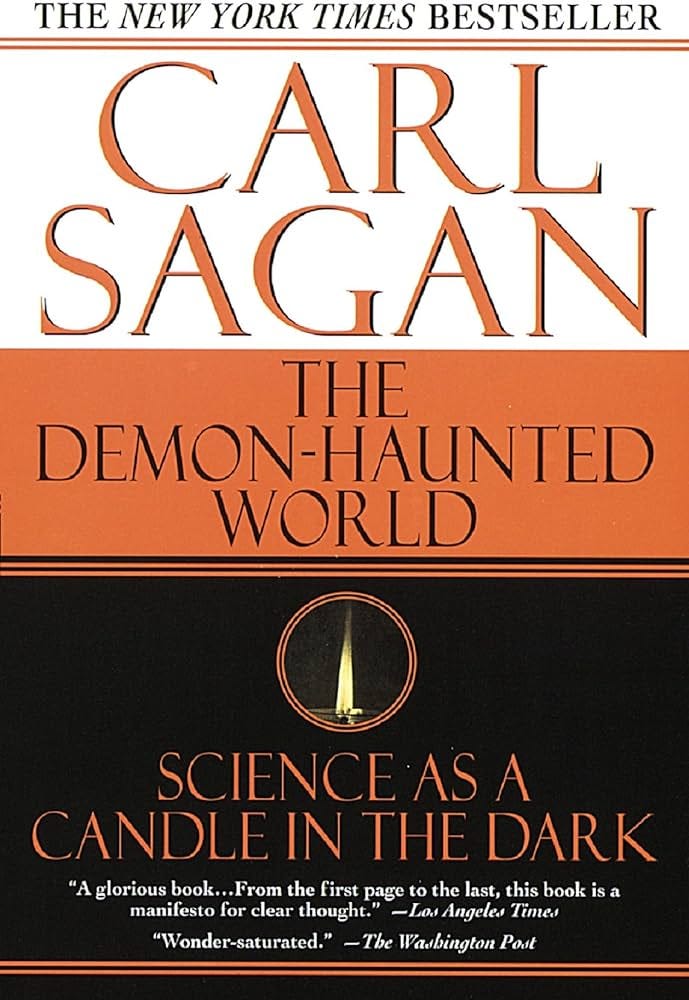A Spark to Ward off the Demons (#118)
A review of a prescient classic. (No, seriously, was Carl Sagan a wizard?)
I have a foreboding of an America in my children's or grandchildren's time —when the United States is a service and information economy; when nearly all the key manufacturing industries have slipped away to other countries; when awesome technological powers are in the hands of a very few, and no one representing the public interest can even grasp the issues; when the people have lost the ability to set their own agendas or knowledgeably question those in authority; when, clutching our crystals and nervously consulting our horoscopes, our critical faculties in decline, unable to distinguish between what feels good and what's true, we slide, almost without noticing, back into superstition and darkness.
- Carl Sagan, The Demon-Haunted World
I’m hesitant to create things like lists of “must-read” books. People’s tastes vary over time, even depending on the day, and a perfect book that one devours may have well been less than appetizing a few months or a year prior.
Yet, here we are, with an entry onto this impossible list: the Carl Sagan classic, The Demon-haunted World: Science As A Candle In The Dark.
I’ve had it on my book shelf for years, yet only just read it a few weeks ago. It wasn’t the right time before - despite having been in a job whose mandate was to share science, and having a newsletter to the same effect. Perhaps, though, it was exactly for those reasons that I could not yet give it the space and time it needed. A pinot noir can be delectable with the right atmosphere, meal; guzzling it until one is near nausea is not a recipe for enjoyment.
So, earlier this month, I found myself finally ready to reach into my literary wine cellar and select this vintage from 1997. Published months after Dr. Sagan’s death on December 20, 1996, it is a packed tome of insight that some could argue approaches repetition over the course of the 25 chapters and nearly 500 pages. Some could argue that, but not me. All of it is delicious: page after page of the clear and firm prose that many of us were lucky to hear from his engaging baritone on his television program, Cosmos.
He begins with a vignette to set up the premise of the book - a taxi ride with an earnest driver who has plenty of excitement for new discovery but little in the way of scrutiny. Over the course of the drive, the gentleman espouses all manner of conspiracy theory and unsupported claims about aliens, the planets, and so on (only to be let kindly down again and again by his famous passenger). Sagan reflects that his driver “wanted to know about science. It's just that all the science had gotten filtered out before it reached him.”
It’s in this sentence that we can hear his empathy and kindness: He knows this man, and many others before and after him, are intelligent and have capacity to understand more of the mysteries of our world and universe (“A proclivity for science is embedded deeply within us, in all times, places and cultures….When, through indifference, inattention, incompetence, or fear of skepticism, we discourage children from science, we are disenfranchising them, taking from them the tools needed to manage their future…”). It’s emotion, though, that drives the search for aliens and miracle cures: fear of the unknown, fear for a misplaced meaning of life, fear of not having a significant place - of being nothing more than another animal with no higher purpose. Any derision Sagan may have had is instead saved for those who knowingly prey on and profit from misinformation.
Pseudoscience speaks to powerful emotional needs that science often leaves unfulfilled.
Carl Sagan, The Demon-Haunted World
Each chapter unfurls from the previous - a showcase of the paranormal and supernatural myths encountered and perpetuated through an increasingly uncritical media and education system. Aliens, UFOs, repressed memories (a.k.a., wrapping up “…the old gods and demons in scientific raiment and [calling] them aliens…”) - he reviews the ease with which we easily lean into embracing these “truths” with his trademark accessibility and firm, calm enthusiasm for knowledge that transferred easily from his popular TV program to the written page. It’s not that he’s a “non-believer”; he’s open to any proof to show that a new hypothesis for creation and existence can be supported. He also acknowledges that “it takes work to be skeptical”, and so helps us out halfway through the book with a “baloney detection kit” - a set of tools and approaches any of us can use to scrutinize bold claims.
His criticisms are not just reserved for the loss of skepticism, mind you. Sagan knows that scientists have, historically, done a rubbish job at explaining their work (compounding the spread of disingenuous claims and leaders) and argues that, “…at the very least they should make an extremely serious effort, with dazzling graphics, metaphors, and capable use of the English language, to justify their proposal.”
The ownership to do better rests with everyone: a skeptical public and a warmer, more engaging science.
The book’s final chapters move to perhaps the most haunting of his predictions (in this social and political climate):
Reading this book now - nearly thirty years from his death and the book’s publication - is unsettling at times. What would Carl have thought about the ability to create anything via AI? To move from reporting to complete fact creation? To be castigated for asking questions about the veracity of a claim?
Yes, it’s unsettling, as well as invigorating and a little depressing: Invigorating to inspire change by speaking to “the better angels1 of our nature”2, depressing that we were, and are, so predictable and seemingly unwavering from this poorly-lit path.
But there is a path forward. We have wonderful wine cellars of literature, collections of stories, and means to share them more widely for good:
“…Books, purchasable at low cost, permit us to interrogate the past with high accuracy; to tap the wisdom of our species; to understand the point of view of others, and not just those in power; to contemplate…Books are patient where we are slow to understand, allow us to go over the hard parts as many times as we wish, and are never critical of our lapses. Books are key to understanding the world and participating in a democratic society.
Carl Sagan, The Demon-Haunted World
The question I sit with now, and which I leave to you all, is how can we use them to turn the lights on?
DETAILS
The Demon-haunted World: Science As A Candle In The Dark
Authors: Carl Sagan and Ann Druyan
Publisher: Random House Publishing Group (February 25, 1997)
Language: English (480 pages)
ISBN: 9780345409461
The irony of using a quote with angels in a Sagan book review not being lost on me.
Not Sagan, but Lincoln, in his inauguration speech.







Oh gosh, fascinating, Bryn - thank you so much for your exploration of this book. I'm going to take a look!
I’ll have to wander through the stacks at work and see if we have it! Some very prescient questions - and after a weekend in American news, even more pressing than it was on Friday, somehow?!